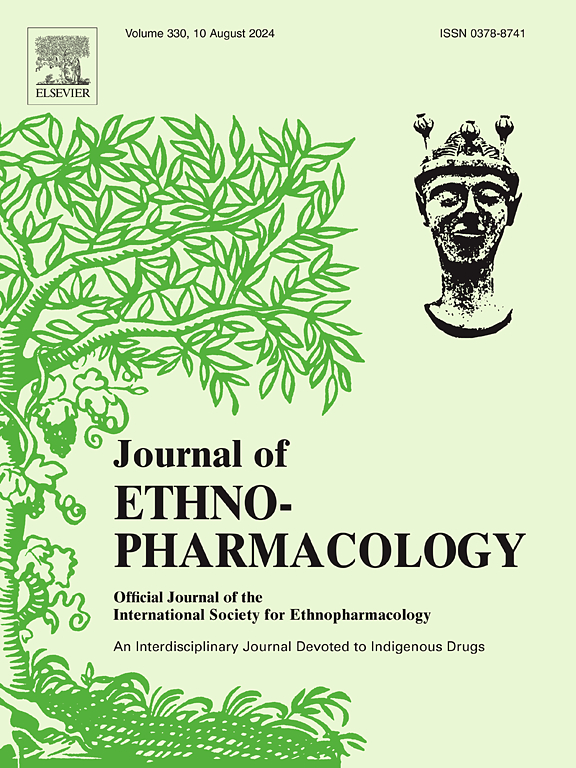Shaoyao Gancao decoction promotes splenic immune homeostasis mediating cGAS-STING signaling pathway to delay autoimmune hepatitis progression
IF 5.4
2区 医学
Q1 CHEMISTRY, MEDICINAL
引用次数: 0
Abstract
Ethnopharmacological relevance
Shaoyao Gancao Decoction (SGD), a classic Chinese herbal formula from the “Treatise on Cold Damage (Shang Han Lun),” is widely used for treating liver disease. However, the efficacy and mechanisms by which SGD delays liver fibrosis progression in autoimmune hepatitis (AIH) require further investigation.
Aim of the study: This study aimed to investigate the mechanisms underlying the SGD-mediated delay of liver fibrosis progression in AIH through the spleen.
Materials and methods
SGD was administered via gavage to mice for 15 days before establishing the concanavalin A (ConA)-induced AIH model. The key factors were identified using bioinformatics analysis. The intervention effects and mechanisms of SGD on AIH were clarified using liver function assay, enzyme-linked immunosorbent assay (ELISA), and histopathological, real-time quantitative PCR (RT-qPCR), immunofluorescence (IF), and Western blot analyses. Hepatic stellate cells (HSCs) were co-cultured with splenic mononuclear cells in a Transwell chamber system.
Results
SGD pretreatment alleviated liver injury, spleen injury, and abnormal liver function in AIH mice. Interleukin-1β (IL-1β) and IL-12 were identified as key factors in SGD intervention of AIH. SGD pretreatment promoted immune homeostasis in the spleen and liver. Additionally, SGD reduced HSC proliferation and activation. Further, SGD decreased cyclic GMP-AMP synthase (cGAS), stimulator of interferon genes (STING), nuclear factor kappa-B (NF-κB), and transforming growth factor-β1 (TGF-β1) expression in the liver and HSCs.
Conclusions
SGD promoted splenic immune homeostasis, which inhibited the hepatic cGAS-STING signaling pathway, thereby attenuating HSC activation and ultimately delaying liver fibrosis progression in AIH.

少药肝草汤通过介导cGAS-STING信号通路促进脾免疫稳态延缓自身免疫性肝炎进展
民族药理学相关性:少药肝草汤(SGD)是《伤寒论》中的经典中药配方,被广泛用于治疗肝病。然而,SGD延缓自身免疫性肝炎(AIH)肝纤维化进展的疗效和机制需要进一步研究。研究目的:本研究旨在探讨sgd介导的通过脾脏延缓AIH肝纤维化进展的机制。材料和方法:在建立ConA诱导的AIH模型之前,将SGD灌胃15 d。利用生物信息学分析确定了关键因素。通过肝功能测定、酶联免疫吸附试验(ELISA)、组织病理学、实时定量PCR (RT-qPCR)、免疫荧光(IF)和western blot分析,明确SGD对AIH的干预作用和机制。肝星状细胞(hsc)与脾单核细胞在Transwell室系统中共培养。结果:SGD预处理可减轻AIH小鼠肝损伤、脾损伤及肝功能异常。白细胞介素-1β (IL-1β)和IL-12被确定为SGD干预AIH的关键因素。SGD预处理促进脾脏和肝脏的免疫稳态。此外,SGD还能降低HSC的增殖和活化。此外,SGD还能降低环GMP-AMP合成酶(cGAS)、干扰素基因刺激因子(STING)、核因子κ b (NF-κB)和转化生长因子-β1 (TGF-β1)在肝脏和造血干细胞中的表达。结论:SGD促进脾免疫稳态,抑制肝脏cGAS-STING信号通路,从而减弱HSC活化,最终延缓AIH肝纤维化进展。
本文章由计算机程序翻译,如有差异,请以英文原文为准。
求助全文
约1分钟内获得全文
求助全文
来源期刊

Journal of ethnopharmacology
医学-全科医学与补充医学
CiteScore
10.30
自引率
5.60%
发文量
967
审稿时长
77 days
期刊介绍:
The Journal of Ethnopharmacology is dedicated to the exchange of information and understandings about people''s use of plants, fungi, animals, microorganisms and minerals and their biological and pharmacological effects based on the principles established through international conventions. Early people confronted with illness and disease, discovered a wealth of useful therapeutic agents in the plant and animal kingdoms. The empirical knowledge of these medicinal substances and their toxic potential was passed on by oral tradition and sometimes recorded in herbals and other texts on materia medica. Many valuable drugs of today (e.g., atropine, ephedrine, tubocurarine, digoxin, reserpine) came into use through the study of indigenous remedies. Chemists continue to use plant-derived drugs (e.g., morphine, taxol, physostigmine, quinidine, emetine) as prototypes in their attempts to develop more effective and less toxic medicinals.
 求助内容:
求助内容: 应助结果提醒方式:
应助结果提醒方式:


